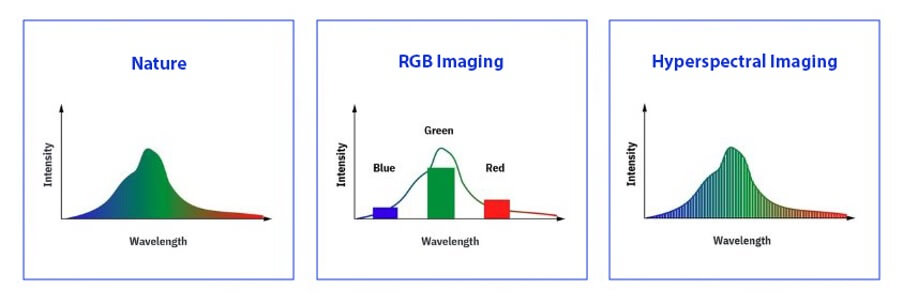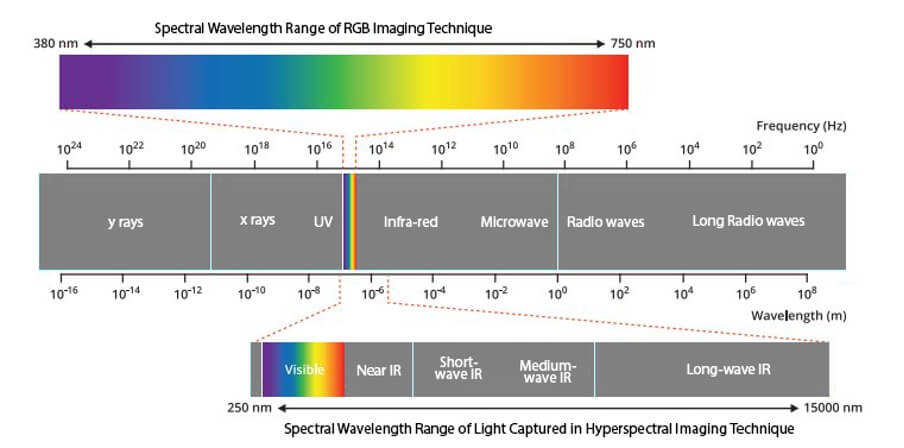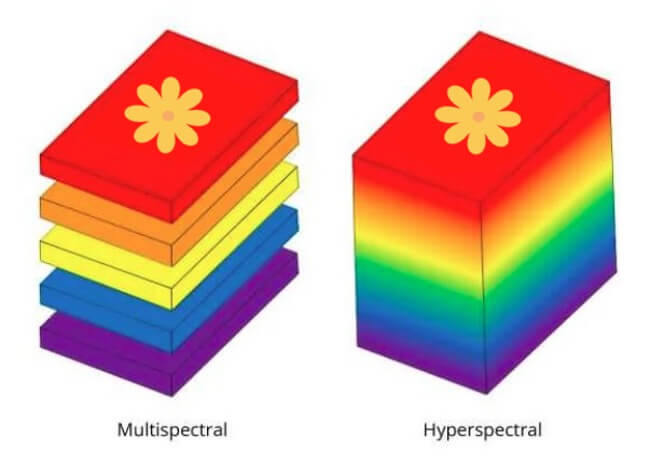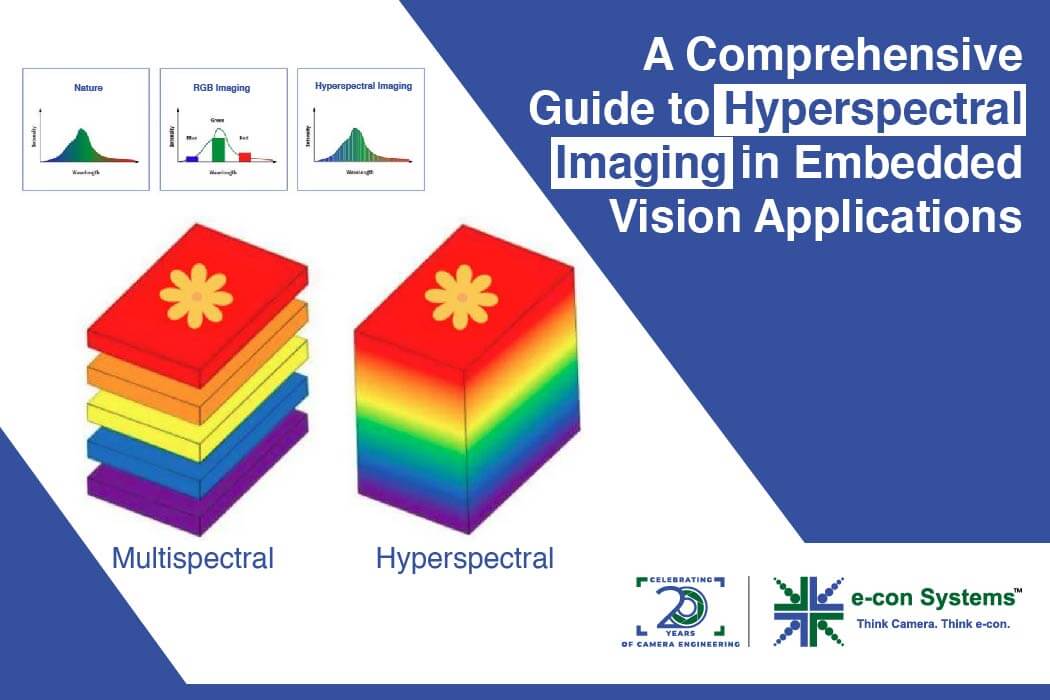Spectral imaging is a technique where devices can see beyond the colors human eyes can and capture information from many more wavelengths of light, not just red, green, and blue. This helps capture details invisible to the naked eye.
Spectral imaging is like a super camera that splits light into many colors, hundreds or even thousands! Things that human eyes are incapable of, like night vision, X-ray vision, etc., become possible with spectral imaging based on the type of light used.
By capturing all these extra colors (or wavelengths) of light, spectral imaging creates a “chemical map” of the object being imaged. It can be used for applications such as identifying the composition of materials, analyzing the health of plants or human tissues, hidden details in paintings or documents, etc.
In this blog, we will explore hyperspectral imaging and how it compares to other modes of imaging. Read on!
What is Multispectral Imaging?
Multispectral imaging (MSI) captures images across multiple specific wavelength ranges of the electromagnetic spectrum. Multispectral imaging wavelength is a range of selected number of spectral bands (typically 2-15). These bands can encompass visible light (0.4-0.7 µm), Ultraviolet (UV), Near-Infrared (NIR), Short-Wave Infrared (SWIR), Mid-Wave Infrared (MWIR), or Long-Wave Infrared (LWIR).
The cameras used for multispectral imaging can employ filters that isolate specific wavelength ranges or utilize detectors sensitive to particular frequencies. Sensors integrate multiple photodetectors per pixel, each capturing data in a distinct band (similar to a Bayer filter in RGB cameras). During the image capture, the system records the intensity of light for each chosen wavelength band at each pixel location. This results in a multidimensional dataset, where each pixel holds a value for each spectral band, forming a “spectral signature”.
Multispectral imaging is commonly used for material identification, invisible feature detection, and quantitative analysis. Applications of multispectral imaging include remote sensing, medical imaging, and more.
Types of Multispectral Imaging Techniques
- Fixed-Filter Multispectral: In this technique, the sensor has a pre-defined set of spectral filters that allows only specific wavelength ranges to pass through. These filters are chosen based on the application (e.g., for vegetation analysis, filters for visible green, red, and near-infrared bands can be used). It’s like having a camera with a few extra color filters compared to a regular RGB camera.
- Tunable Filter Multispectral: This approach uses a tunable filter that can be electronically adjusted to select different wavelength ranges. This offers more flexibility in band selection compared to fixed filters but might be slower for acquiring data across multiple bands.
- Spectral Scanning Multispectral: Here, a single detector captures data across different wavelengths by using a technique like a diffraction grating. This allows for capturing a wider range of wavelengths compared to fixed filters but might have lower signal-to-noise ratio and require complex calibration.
What is Hyperspectral Imaging?
In hyperspectral imaging, the hyperspectral remote sensors collect images in thousands of narrow and closely spaced contiguous spectral bands. These bands provide a very detailed picture of the light spectrum. This makes it possible to identify even subtle variations in color with high detailing.
 Hyperspectral imaging offers a high spectral resolution, as it captures data in large numbers of spectral bands. It allows for highly detailed analysis and identification of specific materials based on their unique spectral signatures (like a fingerprint for light).
Hyperspectral imaging offers a high spectral resolution, as it captures data in large numbers of spectral bands. It allows for highly detailed analysis and identification of specific materials based on their unique spectral signatures (like a fingerprint for light).
 How does Hyperspectral Imaging differ from Multispectral Imaging?
How does Hyperspectral Imaging differ from Multispectral Imaging?
Compared to hyperspectral imaging, multispectral imaging captures data only in a limited number of spectral bands (typically 4 to 10). The bands are often pre-selected based on the specific application. It is an imaging technique with fewer extra color filters than a regular RGB camera.
Multispectral imaging offers lower spectral resolution because of fewer and broader bands. Compared with hyperspectral imaging, it can only differentiate between a limited range of colors or materials.
An analogy to distinguish between multispectral and hyperspectral imaging techniques and their application is given below.
In a farmland, the purpose of multispectral and hyperspectral imaging will be as given below.
- Multispectral Imaging: Multispectral imaging provides a general overview of crop health and can highlight areas of concern, such as water stress or pest infestation.
- Hyperspectral Imaging: Hyperspectral imaging, farmers can detect very specific problems in their crops, like identifying a particular disease or nutrient deficiency based on the unique spectral signature of affected plants.
 The choice between multispectral and hyperspectral imaging depends on the required level of detail. For instance, if you need to differentiate between a few broad categories, multispectral imaging can be sufficient. However, if highly detailed material identification and analysis is required, hyperspectral imaging is the ideal choice.
The choice between multispectral and hyperspectral imaging depends on the required level of detail. For instance, if you need to differentiate between a few broad categories, multispectral imaging can be sufficient. However, if highly detailed material identification and analysis is required, hyperspectral imaging is the ideal choice.
Embedded Vision Applications of Hyperspectral Imaging
- Smart Agriculture: Hyperspectral cameras mounted on drones or satellites capture data across the visible, NIR, and SWIR ranges. Specific bands within these regions correspond to plant health indicators like chlorophyll content, water stress, and nutrient deficiencies.
- Environmental Monitoring: HSI data is used to monitor various environmental parameters. Capturing data in the visible and NIR bands helps assess vegetation health, while SWIR bands can be used to identify water pollutants or track oil spills. HSI helps track deforestation patterns and assess forest health by analyzing changes in vegetation cover over time.
- Diagnostics and Treatments in the Medical Industry: Hyperspectral imaging can be used during surgeries to identify tumor margins or differentiate between different types of tissue in real-time, leading to more precise and minimally invasive procedures.
HSI is also used to diagnose various diseases, such as cancer, as it can differentiate between healthy and cancerous tissues based on subtle spectral variations. This can aid in early cancer detection, improving treatment outcomes. By tracking changes in tissue composition over time, HSI also guides in monitoring wound healing progress and identifying potential complications like infections.
Spectral Imaging Cameras Offered by e-con Systems
e-con Systems is an industry pioneer with 20+ years of experience in designing, developing, and manufacturing OEM cameras.
Our range of cameras includes spectral imaging cameras built for industrial, medical, and retail applications. Our cameras are compatible with popular NVIDIA Jetson processing platforms and host our high-speed ISPs.
We also provide customization services to ensure the right camera meets the demands of your unique application and its use cases.
Check out our Markets Page to know more about us.
Write to us at camerasolutions@e-consystems.com for queries and more information.

Prabu is the Chief Technology Officer and Head of Camera Products at e-con Systems, and comes with a rich experience of more than 15 years in the embedded vision space. He brings to the table a deep knowledge in USB cameras, embedded vision cameras, vision algorithms and FPGAs. He has built 50+ camera solutions spanning various domains such as medical, industrial, agriculture, retail, biometrics, and more. He also comes with expertise in device driver development and BSP development. Currently, Prabu’s focus is to build smart camera solutions that power new age AI based applications.




